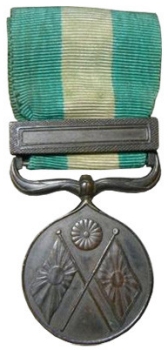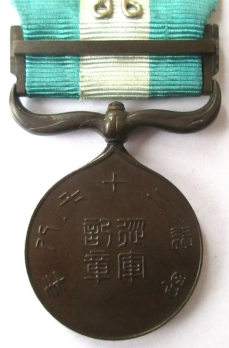Prior to the War, China had a long-standing tributary/suzerain relationship with Korea, which Japan resented because it limited Japans ability to maneuver within Korea. The list of historical events leading up to the war is far too long to relate here. The result was that on July 25, 1894, the first battle, the Battle of Pungdo, commenced. On August 1, 1894, war was officially declared between China and Japan. This 1st Sino-Japanese War (25 July 1894 – 17 April 1895) was primarily a conflict between China and Japan over who was to have paramount influence in Korea. The war was pretty much lopsided in Japans’ favor, and the Chinese government was forced to sue for peace in February 1895. The war had clearly demonstrated China’s failure to modernize its military. The war is commonly known in China as the War of Jiawu (甲午戰爭 갑오전쟁) which refers to the year (1894) using the traditional sexagenary calendar system. In Japan, it is called the Japan–Ching War (日清戦争 일청전쟁), and in Korea it is called the Qing–Japan War (淸日戰爭 청일전쟁). The Treaty of Shimonoseki was signed on April 17, 1895. By this treaty, China formally recognized the total independence of Korea and ceded the Liaodong Peninsula (遼東半島), Taiwan and Penghu Islands to Japan. With its victory established, Japan became a dominant power in Asia, but it also heightened Japanese ambitions of aggression and military expansion in Asia. Several Chinese officials in Taiwan resisted the cession of Taiwan to Japan, and on May 23rd declared the island to be the independent Republic of Formosa. On May 29th, Japanese forces landed on Taiwan and conducted a brutal five-month campaign, which didn’t end until October 21, 1895. Even today, the atrocities committed by the Japanese in 1895, have not been forgotten.
Two years after the Treaty of Shimonoseki, in October 1897, Korea proclaimed itself to be the Korean Empire (대한제국, 大韓帝國) and announced its complete independence from the Ching Empire. King Kojong (고종, 高宗) changed his title to Emperor Kwangmu (광무, 光武, “Shining and Martial”). 1
The 1894-1895 Sino-Japanese War Medal


The Japanese Imperial Edict announcing the “1894-1895 War Medal” was signed by the Emperor on Oct. 8, 1895.
The metal used for the medal was the bronze from captured Chinese cannons (which were purportedly manufactured in the USA). In July and Aug. of 1895, 53 captured bronze cannons were delivered to the Osaka mint to be made into 105,000 medals.
The obverse side of the planchet features an army regimental standard crossed by a naval ensign, with the emperor’s chrysanthemum above. The bar across the ribbon was left blank, but was kept to maintain a degree of similarity with the earlier 1874 War medal.
In the center of the reverse, is the inscription 従軍記章(종군기장) “War Medal” and around the outside edge, it reads 明治二十七八年 “Meiji 27-28 Year” (1894-95). There is no mention of China, their adversary during the war. This was done because of the political power struggle that ensued immediately after the war. Japan was able to keep much of what it had acquired by the Treaty of Shimonoseki, but was politically forced to give up Liaodong Peninsula after the “Triple Intervention of 23 April 1895” by Russia, France and Germany. At this point, Russia quickly occupied the Liaodong Peninsula and set the stage for Japans’ next major conflict, the Russo-Japanese War.
The colors used for the ribbon were identical to the green and white of the 1874 War Medal, but the width of the stripes were altered. These green and white ribbon colors are also found on the Boxer Rebellion Medal, but ended there and did not carry over into the Russo-Japanese War Medal. The 1894-95 Sino-Japanese War Medal was also Japans’ first war medal to receive the hook and eyelet mountings on the rear of the ribbon.
On Nov. 29, 1895, a memo stated that all award documents were to have the issue date of “Nov. 18, 1895”, which was the day on which Taiwan finally fell and brought an end to the war.
